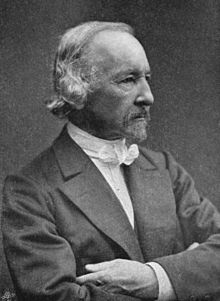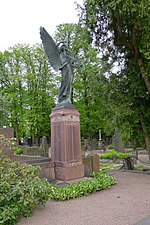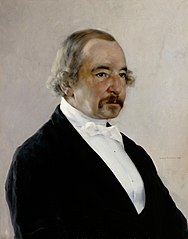| Zachris Topelius | |
|---|---|
 | |
| Born | Zacharias Topelius (1818-01-14)14 January 1818 Kuddnäs, near Nykarleby, Grand Duchy of Finland, Russian Empire (now Finland) |
| Died | 12 March 1898(1898-03-12) (aged 80) Sipoo, Grand Duchy of Finland, Russian Empire (now Finland) |
| Occupation |
|
| Language | Swedish |
| Nationality | Finnish |
Zacharias Topelius (Finland Swedish pronunciation: [sɑˈkɑːriɑs toˈpeːliʉs]; 14 January 1818 – 12 March 1898) was a Finnish author, poet, journalist, historian, and rector of the University of Helsinki who wrote novels related to Finnish history. He wrote his works exclusively in Swedish, although they were translated early on into Finnish.
Given name
Zacharias is his baptismal name, and this is used on the covers of his printed works. However, "he himself most often used the abbreviation Z. or the form Zachris (Finland Swedish pronunciation: [ˈsɑkris]), even in official contexts", as explained in the National Biography of Finland. Zachris is therefore the preferred form used in recent academic literature about him.
The Finnish form of Topelius' first name is Sakari(as) (Finnish pronunciation: [ˈsɑkɑri(ɑs)]).
Life and career
Early life
The original name of the Topelius family was the Finnish name Toppila, which had been Latinized to Toppelius by the author's grandfather's grandfather and later changed to Topelius. Topelius was born at Kuddnäs, near Nykarleby in Ostrobothnia, the son of a physician of the same name (Zacharias Topelius the Elder [fi]), who was distinguished as the earliest collector of Finnish folk songs. His grandfather, Mikael Toppelius, was a painter noted for his murals and altarpieces in churches in Ostrobothnia.
As a child, he heard his mother, Katarina Sofia Calamnius, sing the songs of the Finnish-Swedish poet Frans Michael Franzén. At the age of eleven, he was sent to school in Oulu and boarded with relatives in the possession of a lending library, where he nurtured his imagination with the reading of novels. He was given a Christian upbringing that came to characterize his entire life.
Study in Helsinki

He came to Helsinki in 1831 and became a member of the circle of young nationalist men surrounding Johan Ludvig Runeberg, at whose home he stayed for some time. Topelius became a student at the Imperial Alexander University of Finland in 1833, received his master's degree (cand. philol.) in 1840, the Licentiate degree in history in 1844 and his PhD in 1847, having defended a dissertation titled De modo matrimonia jungendi apud fennos quondam vigente ("About the custom of marriage among the ancient Finns"). Besides history, his academic studies had for periods been devoted both to Theology and Medicine. He was secretary of Societas pro Fauna et Flora Fennica [fi] 1842–1846, was employed by the university library 1846–1861, and taught History, Statistics and Swedish at the school Helsingfors lyceum [fi] during the same period.
Becoming a professor
Through the intervention of a friend, Fredrik Cygnaeus, Topelius was named professor extraordinary of the History of Finland at the university in 1854. He was made first ordinary professor of Finnish, Russian and Nordic history in 1863, and exchanged this chair for the one in general history in 1876. He was rector of the university from 1875 until 1878, when he retired as Emeritus Professor and received the title of verkligt statsråd (Finnish: todellinen valtioneuvos, Russian: действительный статский советник; literally "state councillor", a Russian honorary title).

Focus on writing

Quite early in his career he began to distinguish himself as a lyric poet, with the three successive volumes of his Heather Blossoms (1845–54). The earliest of his historical romances was The Duchess of Finland, published in 1850. He was also editor-in-chief of the Helsingfors Tidningar [fi] from 1841 to 1860. In 1878, Topelius was allowed to withdraw from his professional duties, but this did not sever his connection with the university; it gave him, however, more leisure for his abundant and various literary enterprises. Of all the multifarious writings of Topelius, in prose and verse, that which has enjoyed the greatest popularity is his Tales of a Barber-Surgeon, episodes of historical fiction from the days of Gustavus II Adolphus to those of Gustavus III, treated in the manner of Sir Walter Scott; the five volumes of this work appeared between 1853 and 1867. Topelius attempted to write drama, too, enjoying the most success with his tragedy Regina von Emmeritz (1854). Topelius aimed at the cultivation of a strong Finnish patriotism. He wrote a poem which Jean Sibelius used for a composition with a political statement, Islossningen i Uleå älv.
Together with the composer Friedrich Pacius, he wrote the libretto (in the style of Romantic nationalism) to the first Finnish opera: Kaarle-kuninkaan metsästys (Swedish: Kung Karls jakt, English: King Charles' Hunt). Topelius initially thought of writing a trivial entertainment, but having heard extracts from the opera project at a concert in 1851, he realized that Pacius was writing a grand opera on the theme of salvation, following the early Romantic style of Carl Maria von Weber's Der Freischütz (1821) and Oberon (1826). Topelius wrote the libretto in Swedish (though it was translated later by others), but its subject is emphatically Finnish. He also wrote the libretto for Prinsessan av Cypern, set by Fredrik Pacius and Lars-Erik Larsson.

Death
Topelius died in his manor house in Koivuniemi, Sipoo, Finland, where he wrote his greatest works. He is buried in the Hietaniemi Cemetery in Helsinki.
Legacy
According to tradition, the modern flag of Finland was based on a design by Topelius in about 1860.
There was a small Finnish American village named after Topelius, platted in 1901 in Otter Tail County, Minnesota, US.
Selected works
- The Tomten in Åbo Castle, 1849 (Swedish: Tomtegubben i Åbo slott, Finnish: Turun linnan tonttu-ukko)
- Sov du lilla vide ung, 1869 (Trollsländan)
- Nu så kommer julen, 1857
- Boken om vårt land, 1875 (Maamme-kirja, Book of Our Land)
- Vinterqvällar, 1881 (Talvi-iltain tarinoita)
- Fältskärns berättelser, 1884 (Välskärin kertomukset)
- Läsning för barn, 1881 (Lukemisia lapsille)
- Stjärnornas kungabarn, 1899–1900 (Tähtien turvatit)
- Sampo Lappelill (1860)
Gallery
-
 Painted by Gunnar Berndtson in 1880
Painted by Gunnar Berndtson in 1880
-
 Portrait by Albert Edelfelt, 1889
Portrait by Albert Edelfelt, 1889
-
Portrait by Maria Wiik, 1890
-
Topelius and Children by Ville Vallgren in Helsinki, 1932
| Educational offices | ||
|---|---|---|
| Preceded byAdolf Moberg [sv; fi] | Rector of Imperial Alexander University 1875–1878 |
Succeeded byWilhelm Lagus [sv; fi] |
References
- Schoolfield, George C., ed. (1998). A History of Finland's Literature. Histories of Scandinavian Literature. Lincoln: University of Nebraska Press. pp. xvii. ISBN 978-0-8032-4189-3.
In the full flush of nationalistic enthusiasm Finnish literary histories were written largely without reference to what had happened and was happening in the other tongue, save for the work of such giants as Johan Ludvig Runeberg and Zachris Topelius: because of their role in national life, and thanks to early and excellent translation, they were regarded as essential parts of Finnish-language literature, albeit they wrote entirely in Swedish.
- 100 faces from Finland by Ulpu Marjomaa, (Helsinki: Finnish literature society, 2000)
- ^
 One or more of the preceding sentences incorporates text from a publication now in the public domain: Gosse, Edmund William (1911). "Topelius, Zakris". In Chisholm, Hugh (ed.). Encyclopædia Britannica. Vol. 27 (11th ed.). Cambridge University Press. p. 49.
One or more of the preceding sentences incorporates text from a publication now in the public domain: Gosse, Edmund William (1911). "Topelius, Zakris". In Chisholm, Hugh (ed.). Encyclopædia Britannica. Vol. 27 (11th ed.). Cambridge University Press. p. 49.
- Schoolfield 1998, p. 334.
- Boije, Erika (2022). "Inledning". In Magnus Nylund (ed.). Zacharias Topelius, Religiösa skrifter och psalmer (in Swedish). Helsinki: Svenska litteratursällskapet i Finland. ZTS XIX, SSLS 867.
- Liukkonen, Petri. "Zachris Topelius". Books and Writers (kirjasto.sci.fi). Finland: Kuusankoski Public Library. Archived from the original on 21 February 2015.
- "Hietaniemen hautausmaa – merkittäviä vainajia" (PDF). Helsingin seurakuntayhtymä. Retrieved 26 August 2016.
- Inglefield, Eric (1978). Flags. Ward Lock. p. 53.
- Topelius, Zacharias (1881). Whisperings in the Wood, trans. of Läsning för barn by Albert Alberg.
- "Review of Whisperings in the Wood translated from the Swedish of Z. Topelius by Albert Alberg". Saturday Review of Politics, Literature, Science and Art. 52 (1351): 362–363. 17 September 1881.
Further reading
- Zacharias Topelius hundraårsminne : festskrift den 14 januari 1918., Skrifter utgivna av Svenska litteratursällskapet i Finland (in Swedish), Helsinki: Society of Swedish Literature in Finland, 1918, ISSN 0039-6842, Wikidata Q113518858
- Nils Erik Forsgård (1998), I det femte inseglets tecken : en studie i den åldrande Zacharias Topelius livs- och historiefilosofi / Nils Erik Forsgård., Skrifter utgivna av Svenska litteratursällskapet i Finland (in Swedish), Helsinki: Society of Swedish Literature in Finland, ISSN 0039-6842, Wikidata Q113529966
- August Martin Granér (1946), Zachris Topelius' kärlekslyrik / Martin Granér., Skrifter utgivna av Svenska litteratursällskapet i Finland (in Swedish), Helsinki: Society of Swedish Literature in Finland, ISSN 0039-6842, Wikidata Q113526353
- Birgit Lunelund (1954), Zachris Topelius' tryckta skrifter : bibliografisk förteckning / Birgit Lunelund-Grönroos., Skrifter utgivna av Svenska litteratursällskapet i Finland (in Swedish), Helsinki: Society of Swedish Literature in Finland, ISSN 0039-6842, Wikidata Q113526987
- Zachris Topelius; Paul Nyberg (1956), Konstnärsbrev : Z. Topelius brevväxling med C. J. L. Almquist, J. L. Runeberg, Fredrika Runeberg, Fredrik Cygnaeus, Fredrik Pacius, Conrad Greve, J. A. Josephson. Band 1 / [Zacharias Topelius] ; utg. av Paul Nyberg., Skrifter utgivna av Svenska litteratursällskapet i Finland (in Swedish), Helsinki: Society of Swedish Literature in Finland, ISSN 0039-6842, Wikidata Q113527033
- Zachris Schalin (1935), Kuddnäs : skalden Z. Topelius' forna hemgårds historia / Zachris Schalin., Skrifter utgivna av Svenska litteratursällskapet i Finland (in Swedish), Helsinki: Society of Swedish Literature in Finland, ISSN 0039-6842, Wikidata Q113519071
- Zachris Topelius; Bernhard von Beskow; Fredrika Bremer; et al. (1960), Konstnärsbrev. Band 2, Z. Topelius brevväxling med Fredrika Bremer, Bernhard von Beskow, Johan Ludvig Heiberg, Johanne Luise Heiberg, Carl Anton Wetterbergh, Herman Sätherberg, Karl Robert Malmström, Ludvig Leonard Laurén / utgivna av Paul Nyberg., Skrifter utgivna av Svenska litteratursällskapet i Finland (in Swedish), Helsinki: Society of Swedish Literature in Finland, ISSN 0039-6842, Wikidata Q113528410
External links
- Zachris Topelius at the Lied and Art Song Archive
- Zachris Topelius at the Biographical Centre of the Finnish Literature Society
- Zacharias Topelius at 375 Humanists, University of Helsinki, Faculty of Arts. 20 June 2015.
- The childhood home of Zachris Topelius, Kuddnäs, Museum
- Swedish language pages
- Zacharias Topelius skrifter
- Topelius i Nordisk familjebok
- Nordisk familjebok, vol. 29, col. 352ff
- "Zacharias Topelius". Biografiskt lexikon för Finland (in Swedish). Helsingfors: Svenska litteratursällskapet i Finland. urn:NBN:fi:sls-4599-1416928957205.
- Books in Swedish, Finnish and English
- Works by Zacharias Topelius at Project Runeberg
- Works by Zachris Topelius at Project Gutenberg
- Works by or about Zachris Topelius at the Internet Archive
- Works by Zachris Topelius at LibriVox (public domain audiobooks)

- Lyrics
- Audio
| Romanticism | |||||||||||||||||||||||
|---|---|---|---|---|---|---|---|---|---|---|---|---|---|---|---|---|---|---|---|---|---|---|---|
| Countries | |||||||||||||||||||||||
| Movements | |||||||||||||||||||||||
| Themes | |||||||||||||||||||||||
| Writers |
| ||||||||||||||||||||||
| Musicians |
| ||||||||||||||||||||||
| Philosophers | |||||||||||||||||||||||
| Visual artists |
| ||||||||||||||||||||||
| Scholars | |||||||||||||||||||||||
| Related topics |
| ||||||||||||||||||||||
| ← Age of Enlightenment Modernism → | |||||||||||||||||||||||
- Zacharias Topelius
- 1818 births
- 1898 deaths
- People from Nykarleby
- People from Vaasa Province (Grand Duchy of Finland)
- 19th-century historians from the Russian Empire
- Finnish poets in Swedish
- Poets from the Russian Empire
- Writers from Ostrobothnia (region)
- 19th-century Finnish poets
- Finnish male poets
- 19th-century Finnish writers
- Finnish male writers
- Burials at Hietaniemi Cemetery
- 19th-century male writers
- Opera librettists
- Rectors of the University of Helsinki